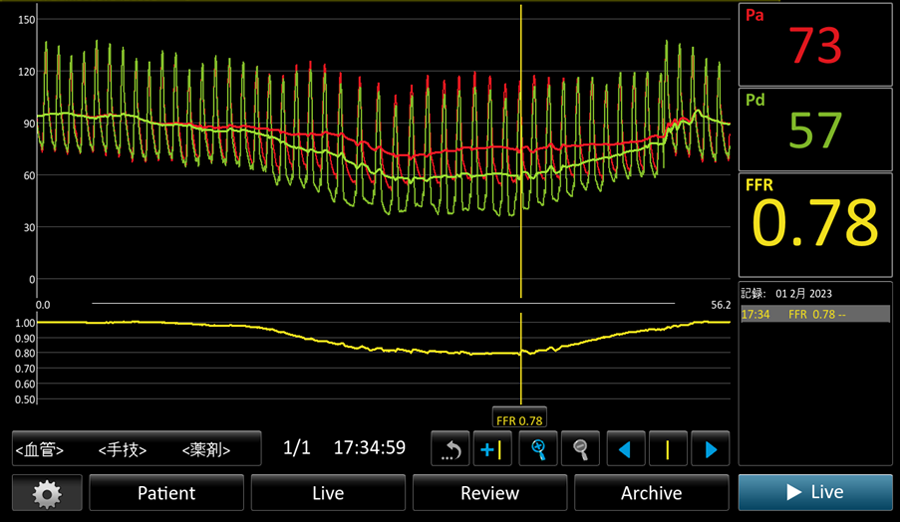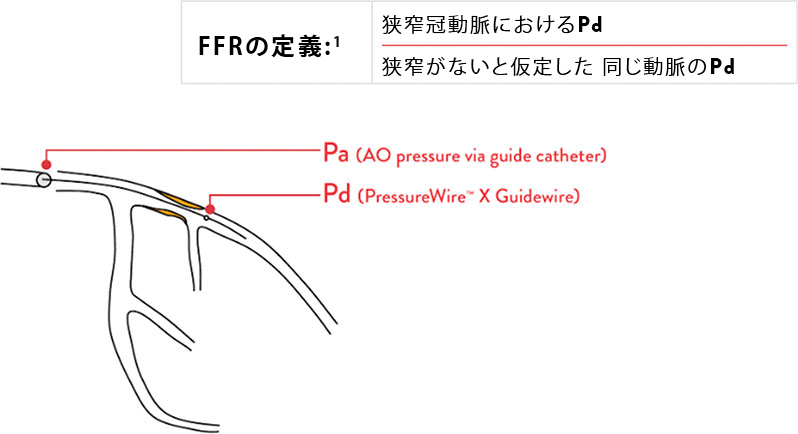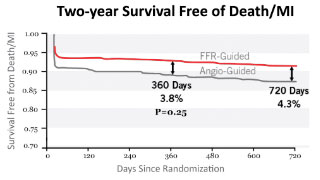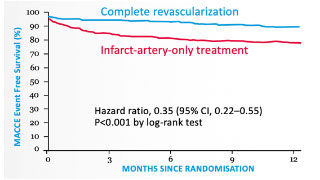FFR - 心筋血流予備量比
虚血の重症度を評価し、血行再建の必要性を判断するために、心筋血流予備量比(FFR)を使用します。FFRは最大充血時の心外膜血管における狭窄の機能的重症度の判別に役立ちます1。
ワイヤレスのPressureWire™ X ガイドワイヤーおよびCoroFlowを使用することにより、FFR値の取得や記録がより簡便になります。

FFRの測定
FFRは、心筋への酸素供給を妨げる可能性がある狭窄が、生理学的にどの程度重要であるかを判断するための指標です。測定値は対象枝全体の重症度を反映した指標です。

※Pa(ガイディングカテーテルによって測定された冠動脈入口部の圧)
※Pd(PressureWire™ X ガイドワイヤーによって測定された冠動脈遠位部の圧)
FFRを使用する理由
PCIを対象としたFFRのカットオフ値は0.80といわれています2。
- FFRが≤0.80の場合、経皮的冠動脈インターベンション(PCI)が遠隔期のMIと緊急血行再建の発生を低減させたことが報告されています
- FFRが>0.80場合、一般に血行再建の対象にはなりません

34%
血管造影での診断が不正確な割合
冠動脈造影は、FFR と比較して、34%の症例で狭窄の機能的重症度の診断が正確にできません3。
35%
FFRによる死亡/MIの低減

FFRに基づいた経皮的冠動脈インターベンション(PCI)は、血管造影のみで治療可否を判断した場合と比較して、死亡および心筋梗塞(MI)のリスクを35%低下させます4。
65%
MACCEにおける相対リスク低減

COMPARE-ACUTE試験では、PressureWire™ X Guidewireによる完全血行再建術は、1年で心臓および脳血管イベント(MACCE)の相対リスクを65%減少させました5。未治療の「FFR陽性」の非梗塞関連動脈病変が、1年次における31%のMACCE発生率と相関していることが報告されています5。
FFRと安静時指標(RFR)の有効活用6
| FFRの使用が有効なケース | ||
|---|---|---|
| 安静時指標 | FFR | |
| 左主幹部病変7 | – | +++ |
| 左室機能障害8 | – | +++ |
| PCI 後の側枝評価9 | – | +++ |
| PCI後の評価10 | – | +++ |
| 同等に有効なケース | ||
| 多枝病変11 | +++ | +++ |
| 糖尿病12 | +++ | +++ |
| 安静時指標(RFR)の使用が有効なケース | ||
| タンデム病変13 | +++ | + |
| びまん性病変14 | +++ | + |
| 左前下行枝15 | +++ | ++ |
| 急性冠症候群16 | +++ | ++ |
References
- Pijls NH, De Bruyne B, Peels K, et al. Measurement of fractional flow reserve to assess the functional severity of coronary-artery stenoses. N Engl J Med. 1996;334(26):1703-1708.
- Panagiotis X, et al. Five-Year Outcomes with PCI Guided by Fractional Flow Reserve. N Engl J Med. 2018; 379:250-259
- Corcoran D, Hennigan B, Berry C. Fractional flow reserve: a clinical perspective. Int J Cardiovasc Imaging. 2017;33(7):961‐974. doi:10.1007/s10554-017-1159-2
- Pijls NH, Fearon WF, Tonino PA, et al. Fractional flow reserve versus angiography for guiding percutaneous coronary intervention in patients with multivessel coronary artery disease: 2-year follow-up of the FAME (Fractional Flow Reserve Versus Angiography for Multivessel Evaluation) study. J Am Coll Cardiol. 2010;56(3):177‐184. doi:10.1016/j.jacc.2010.04.012
- Smits PC, Abdel-Wahab M, Neumann FJ, et al. Fractional flow reserve–guided multivessel angioplasty in myocardial infarction. N Engl J Med. 2017; 376:1234-1244. doi:10.1056/NEJMoa1701067.
- Ali Z. Invasive Assessment of Coronary Physiology Is Here to Stay! TCT 2019.
- Mallidi J, Atreya AR, Cook J, et al. Long-term outcomes following fractional flow reserve-guided treatment of angiographically ambiguous left main coronary artery disease: a meta-analysis of prospective cohort studies. Catheter Cardiovasc Interv. 2015;86(1):12-18.
- Di Gioia G, De Bruyne B, Pellicano M, et al. Fractional flow reserve in patients with reduced ejection fraction. Eur Heart J. 2020;41(17):1665-1672.
- Koo BK, Kang HJ, Youn TJ, et al. Physiologic assessment of jailed side branch lesions using fractional flow reserve. J Am Coll Cardiol. 2005;46(4):633-637.
- Johnson NP, Tóth GG, Lai D, et al. Prognostic value of fractional flow reserve: linking physiologic severity to clinical outcomes. J Am Coll Cardiol. 2014;64(16):1641-1654. doi: 10.1016/j.jacc.2014.07.973.
- Escaned J, Collet C, Ryan N, et al. Clinical outcomes of state-of-the-art percutaneous coronary revascularization in patients with de novo three vessel disease: 1-year results of the SYNTAX II study. Eur Heart J. 2017;38(42):3124-3134.
- DEFINE-FLAIR Trial Investigators. Comparison of major adverse cardiac events between instantaneous wave-free ratio and fractional flow reserve–guided strategy in patients with or without type 2 diabetes. JAMA Cardiol. 2019;4(9):857-864.
- Kikuta Y, Cook CM, Sharp ASP, et al. Pre-angioplasty instantaneous wave-free ratio pullback predicts hemodynamic outcome In humans with coronary artery disease: primary results of the International MulticenteriFR GRADIENT Registry. J Am Coll Cardiol Intv. 2018;11:757-767.
- Jeremias A, Davies JE, Maehara A, et al. Blinded physiological assessment of residual ischemia after uccessful angiographic percutaneous coronary intervention: the DEFINE PCI study. JACC Cardiovasc Interv. 2019;12(20):1991-2001.
- Sen S, Ahmad Y, Dehbi HM, et al. Clinical eventsa after deferral of LAD revascularization following physiological coronary assessment. J Am Coll Cardiol. 2019;73(4):444-453.
- Escaned J, Ryan N, Mejía-Rentería H, et al. Safety of the deferral of coronary revascularization on the basis of instantaneous wave-free ratio and fractional flow reserve measurements in stable coronary artery disease and acute coronary syndromes. JACC Cardiovasc Interv. 2018;11(15):1437-1449.
MAT-2304624 v1.0


